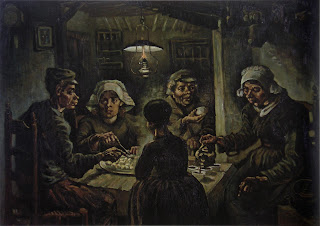 |
| The Potato Eaters-1885 |
The Potato Eaters presents five figures of which three are
females and two are males. One of which appears to be younger than the others
and standing before her family. The meal is simple consisting of baked potatoes
without any type of dressing. Spices were expensive and imported from other
areas.
This meal was a regular staple for people who did not have the access to
the refrigerated varieties we have today. The other woman is serving coffee for
the group through cheap cups and a pot. You can see the conversation within the
picture as the family discusses their daily happenings. One might be talking about the hens and the other about the saving of seeds. Their lives consumed them and filled up their conversational needs. It was all about survival.
The colors are dark which gives the painting a dark and
dirty look. On the ceiling is a single hanging lamp that brightens the families
faces. Even though each female is wearing drab clothing and a bonnet we can see a
touch of youth behind the center figure's face. Life has yet to wear her down as
you can see from the wonderment in her eyes. As a peasant farming family clothing was
likely in high demand and coarse by nature. People simply didn’t throw their
clothes in the washing machine or run down to Macy’s for another pair.
The depiction is a real family in the spirit of naturalism
painting styles. At this time the Great Recession (before the modern one) ran
until 1879. This time was replaced a few decades later by the Great Depression of the 1930’s. The
painting was completed by a young Vincent Van Gogh in 1885 who had not yet
mastered his skills. Poverty was still everywhere as people have not had equal
opportunities to achieve economic footing. It was just the beginning of a more
global economy. This picture is about poverty and the simplicity of life that
existed at the time for a huge percentage of the population.
The painting was originally finished in Netherlands as a
study of “real” people. Vincent van Gogh wanted to depict people as he saw
them. To him these peasants were not only the backbone of the country but also
legitimately earned their food. He stated in a letter, "You see, I really have wanted to make it so
that people get the idea that these folk, who are eating their potatoes by the
light of their little lamp, have tilled the earth themselves with these hands
they are putting in the dish, and so it speaks of manual labor and — that they
have thus honestly earned their food. I wanted it to give the idea of a wholly
different way of life from ours — civilized people. So I certainly don’t want
everyone just to admire it or approve of it without knowing why.”
What Van Gogh was capable of doing was creating a “snap shot”
of life in the rural countryside. Even though they were poor they were still
together. To him people actually worked hard to achieve the things they needed in
their lives. Imagine if we were living back then where backbreaking work was
the norm and only a very few luxuries of life were available. There were no
credit cards, buses, racks of clothing, and medical benefits. With such a hard
time people had an average mortality rate of 50 years or less. Now look around at all the things you have! Do you still have each other? Perhaps their poverty provided them a
rare gift?
No comments:
Post a Comment